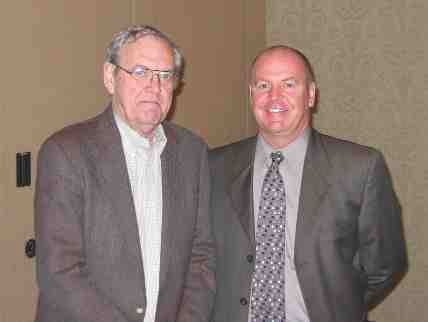
News
Building Health and Safety Leaders One Delegate at a Time
December 1, 2005 By Pulp & Paper Canada

Keynote Speaker Dr. Dan Petersen and PPHSA General Manager Steve Will
Pulp and Paper Health and Safety Conference 2005…
Pulp and Paper Health and Safety Conference 2005
Being vigilant about safety, caring for your fellow workers and putting safety into your own hands were the take home messages of the conference. The one- and a half-day event, organized by the Pulp & Paper Health & Safety Association, consisted of interactive workshops and sessions ranging from environmental hazards to legislative changes to ergonomics in the workplace. This year, delegates attended not only to learn and to network, but also to celebrate the Pulp & Paper Health & Safety Association’s 90th anniversary.
World-renowned health and safety authority Dr. Dan Petersen opened and closed the conference with straight-forward advice and a call for leadership.
“Building a positive safety culture in an organization starts with leadership — a leader perceives the status quo is not good enough.”
He encouraged everyone to be honest about their health and safety culture and programs by asking “where do we stand today in each aspect of the safety effort — where are the strengths and weaknesses?” In making these assessments, he believes people at each level of the organization need to be surveyed, for there are usually vast differences of opinion at the different levels.
Once reality is determined, he says the organization and its leaders can assess the chasm between today and the vision of where the organization should be.
On safety leadership
Roles and responsibilities should be clearly defined for everyone from the CEO to the line supervisor.
For each important corporate safety initiative, identify a safety champion among top corporate managers and task them with driving that initiative.
Ownership by senior management of safety programs and performance should be visible to the organization. Active accountability can be demonstrated through discussion of performance with peers at management review meetings.
On safety performance
Leaders in safety performance use metrics to effectively drive their continuous improvement efforts. Leading indicators are used to predict changes in safety performance. Monitor safety performance versus program implementation at all times.
Performance targets are well-defined and clearly communicated. The targets challenge the organization to continuously improve. The best companies review and reset expectations according to feedback from employees, managers, the performance metrics, and their competition.
Safety performance is rewarded and tied to compensation and/or operating budgets.
Discipline is assessed consistently according to well-developed guidelines.
On communication
Companies that are leaders in safety communication solicit feedback from the recipients of safety information; they put senior managers on the plant floor to ask questions.
On training for safety
Track training requirements to determine the status of training needs and level of compliance.
The leader in training solicits feedback from course attendees and the course sponsor. Safety training is evaluated at the time of information delivery as well as after the fact.
Behaviour observations are used to indicate whether attendees retained the information presented in the training program. Observations are documented and used to modify the training program if needed.
On what works
Build a culture. In the “right” culture behaviors will be appropriate. Start by building a safety culture and then building the system elements that fit your culture and your management philosophy and systems. Assess where you are today, determine where you would like to be, and then take the steps to get there.
Cindy Hunter is a PPHSA Program/Communications Specialist. (705) 474-7233 or www.pphsa.on.ca
Print this page